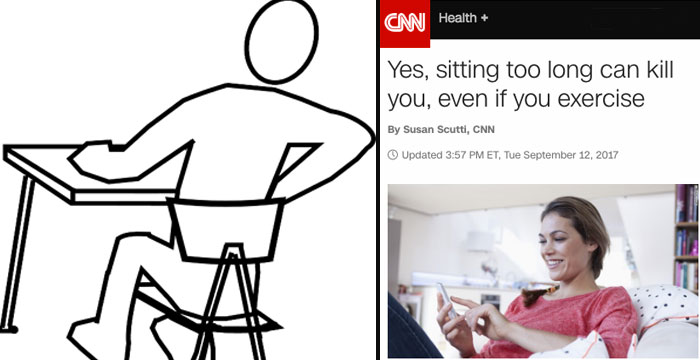Upon first read of this article, I was a bit panicked. I began mentally logging the number of hours I spend in session with clients, writing in front of a computer, sitting in meetings, and laying on my bed reading. Hastily, I wanted to throw all of the chairs and couches out in my home and office and replace them with treadmills and standing desks. I paused…and I took a closer look at the study. Below is a breakdown of the article.
Method
This study is describe as “rigorous and robust” because it utilized a behavioral measure- “hip accelerometer” as opposed to a self-report measure (people tend to be less honest with self-report). Previous studies used mostly self-report measures, which were less behavioral.
This study measured two things: (a) uninterrupted sedentary bout duration (prolonged uninterrupted sedentary behavior) and (b) total sedentary behavior.
The sample of people in the study were middle age (45 years or older, 7985 black and white adults).
Findings
- During the study period, 340 deaths occurred for a variety of reasons, named “all-cause mortality”.
- In this sample, sedentary behavior accounted for about 12.3 hours of an average 16 hour waking day. My comment-“That is a lot of time spent in a seat”.
- The study found a relationship between total sedentary behavior and mortality.
Explanation-“As total sedentary time increased, so did early death by any cause”.
Theory
While there is a relationship between sitting and mortality, the relationship remains unclear. There are two potential theories that attempt to explain the association between these variables.
- Sitting leads to a reduction in insulin sensitivity. That is, a person requires larger amounts of insulin to stabilize blood glucose levels.
- Net calorie expenditures decline as sitting increases. That is, we are not burning calories while we are sitting.
Conclusion
- Subjects with uninterrupted bouts of sedentary behavior had the highest risk for death IF total sedentary behavior also exceeded of 12.5 hours per day.
- In subjects whose sedentary volumes were low, uninterrupted bout lengths (sedentary time) had little if any effects on mortality.
My Take
Our bodies were meant to move, “ambulate” from one place to another. As a society, we are more sedentary and computerized. There is no longer a need to move to get things. Everything we have and need is at our fingertips. Immediate gratification at its best (I mean worst); however, this may compromise our health. In some cultures, walking, running and biking are the primary modes of transportation. Our culture is a fast culture (fast food, fast car, fast lines at the coffee shop).
What you can do
Get Moving!!!Taking a movement break every 30 minutes. Get up, stretch, and walk around. Take a personal inventory of your sedentary behavior. Consider ways that you can easily create a positive change in becoming more active.
Below are a few common sense suggestions:
-Walk to the next class you have
-Avoid the elevator
-Ride your bike to work
-Park far away at the mall and walk to your destination
-Have walking meetings instead of sitting meeting.





